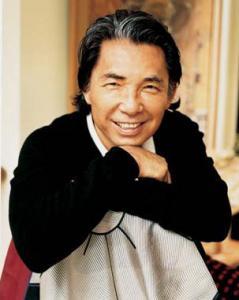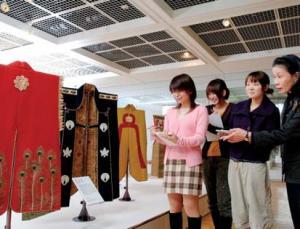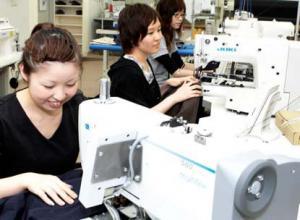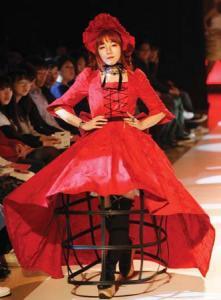Reinventing Western Fashion
By Louise Calvert
The kimono way
 Famous designer, Kenzo Takada -- Photography courtesy of Bunka Gakuen
Famous designer, Kenzo Takada -- Photography courtesy of Bunka Gakuen
In terms of national costume and dress, there can be nothing so quintessentially Japanese as the kimono. These often beautiful and elaborate garments became widespread during the Edo period (1603- 1867) and the craft of creating them tended to be passed down from mothers to daughters in the home. However, during the Meiji era, many Japanese reformers adopted Western style clothing, much to the disgust of the Confucian rulers of China. As Western dress was thus a ‘top-down’ phenomenon, it created within Japan a growing demand for domestically produced garments in the new fashion and by the early twentieth century, it was clear that this emerging industry would need well-trained craftsmen, designers, tailors and machine workers.
It was in such a context that Isaburo Namiki, Japan’s first tailor, and Masajiro Endo, pioneer salesman of Japan’s first sewing machines, combined their schools of dressmaking and sewing respectively to found the Bunka Gakuen, Japan’s first college of fashion, recognized by the Ministry of Education in 1923.
What would set Bunka’s curriculum and style apart from their Western counterparts was their dressmaking technique—inspired by the traditional method of kimono design. To make a kimono, the designer would plan the pattern on paper—the paper pattern was then transferred to the textile.  Traditional methods for modern students Using a very similar technique, Bunka, began educating young women in the ways of design, fabric work and sewing using Masajiro Endo’s own machines. Although the Meiji reformers had first come to wear men’s attire—suits, ties and hats—the trend that Namiki and Endo anticipated was for women’s fashion and the gorgeous dresses that were fast becoming the favorite of elite and aristocratic wives. Thus, the first clients of the school and its graduates were royalty and high society whose patriotism no doubt allowed them to take pride in the fact their Western style robes or gowns were made in Japan using similar techniques to the kimono.
Traditional methods for modern students Using a very similar technique, Bunka, began educating young women in the ways of design, fabric work and sewing using Masajiro Endo’s own machines. Although the Meiji reformers had first come to wear men’s attire—suits, ties and hats—the trend that Namiki and Endo anticipated was for women’s fashion and the gorgeous dresses that were fast becoming the favorite of elite and aristocratic wives. Thus, the first clients of the school and its graduates were royalty and high society whose patriotism no doubt allowed them to take pride in the fact their Western style robes or gowns were made in Japan using similar techniques to the kimono.
As the century drew on, and as the founders had anticipated, Western clothes became the norm, the school grew and grew. In fact 60% of the world’s western clothes are now produced in Asia. The school now comprises eight institutions spread out over a 10-acre area in Shinjuku and has grown to roughly 11,000 students. It runs a wide variety of courses in art, design, languages, fashion, technology and science.
Setting the trend
Although the postwar government of Japan was largely focused on boosting science and technology in pursuit of rapid economic development, Bunka Gakuen quickly established a reputation for itself both at home and abroad. One of its early success stories was Kenzo Takada. As one of the first male students in 1958, he showed exceptional promise and was trained in the unique Bunka style. On graduation he went to Europe and is now a very prestigious designer having his own ‘Kenzo’ brand that is affiliated to Louis Vuitton. The school is proud of his achievements and has a separate ‘Kenzo corner’ in its research facility. Other famous alumni include the designers Hiroko Koshino, Yohji Yamamoto and Tsumori Chisato as well as the actress Naomi Nishida.
During the same period as Kenzo’s rise the school started to build up connections with Christian Dior and Pierre Cardin— the latter was made an honorary professor in 1961. For its students, a degree from Bunka therefore opens up not only excellent career prospects in Japan but also abroad. This has improved in recent years and the energetic international relations department boasts links with almost every major fashion college in the world from the London School of Fashion to the Instituto Marangoni in Milan. In Asia, the school is has assumed a leadership role by bringing its know-how to countries in the region and founding sister school. It created the Beijing Fashion College in 1984 and also has affiliated schools in Thailand, India and South Korea. Membership of the International Federation of Fashion Technology Institutes (IFFTI) is a further boost to Bunka Gaken’s global reach.
 Back to basics
Back to basics
Using its international network, courses involving industry placements offer, student work experience possibilities at every major fashion brand from Issey Miyake to Gucci. The university has thus not only provided the Japanese fashion industry with the human resources and talent that it needs, but has also contributed to the cultural shift of fashion design and fabrication being something done by women in the home to a respected, and glamorous, professional activity. The school maintains its women’s university but also has growing numbers of male students.
The campus itself is a hub of creativity and the designers of tomorrow are given opportunities at every turn to demonstrate their talents. In particular, the school is proud of its fashion shows that are planned to the last detail by the students who act as organizers, designers, makers and even models.
Harmony of parts
Apart from the uniqueness of the Bunka methodology, enshrined in three generations of textbooks, the leaders of the institution have high ideals for their educational philosophy. Essentially they focus on talent, creativity and the ‘harmony of parts’—an emphasis on social responsibility and wider corporate aims. This has led the school into some interesting territory. For one, its students are encouraged to think about labor conditions and natural resources and, in the research department, this has inspired investigation into cutting edge science concerning health.
 From classroom to catwalk
From classroom to catwalk
Executive Board Director, Dr Satoshi Onuma explained to us, “We try to emphasize to our students that one person can do nothing on their own. We have also been trying to push into areas of research that will benefit consumers beyond their aesthetic appearance.” He is especially animated about plans to investigate the potential for particular textiles to have health advantages for the wearer, “We care a lot about what we eat, and the air we breathe but not many people worry too much about the clothes that are next to their skin all day long— evidence shows that certain elements, such as titanium, can be good for both the mind and body. This is something we intend to to look into and test in the future.”
Onuma went on to explain that as well as the high-tech interest, regular students are still taught the essential skills such as sewing. The school has multiple patents for machines that make clothes or facilitate design but the basics remain unchanging, as does the unique teaching of Bunka’s curriculum.
Another element of harmony in the Bunka Gakuen system relates to its internationalization. While it is reaching out and sending its students and staff around the world it also takes a significant number of foreign students, particularly from Asia, and has even set up an institute for teaching Japanese language to students from abroad.
Contact details
Bunka Gakuen
3-22-1 Yoyogi
Shibuya-ku, Tokyo
151-8521
Tel: 81-3-3299-2105
Web: http://bwu.bunka.ac.jp






Comments
Mohammed MUbash... (not verified)
April 13, 2008 - 04:31
Permalink
Help Assistance
Hi,
Please how can you help me to look for fashion design school and fashion company.
Thank you.
Anonymous (not verified)
October 29, 2008 - 22:53
Permalink
help
can you help me im looking for more pictures of dress with the pipes or tubes [like the red one]does any one no where .